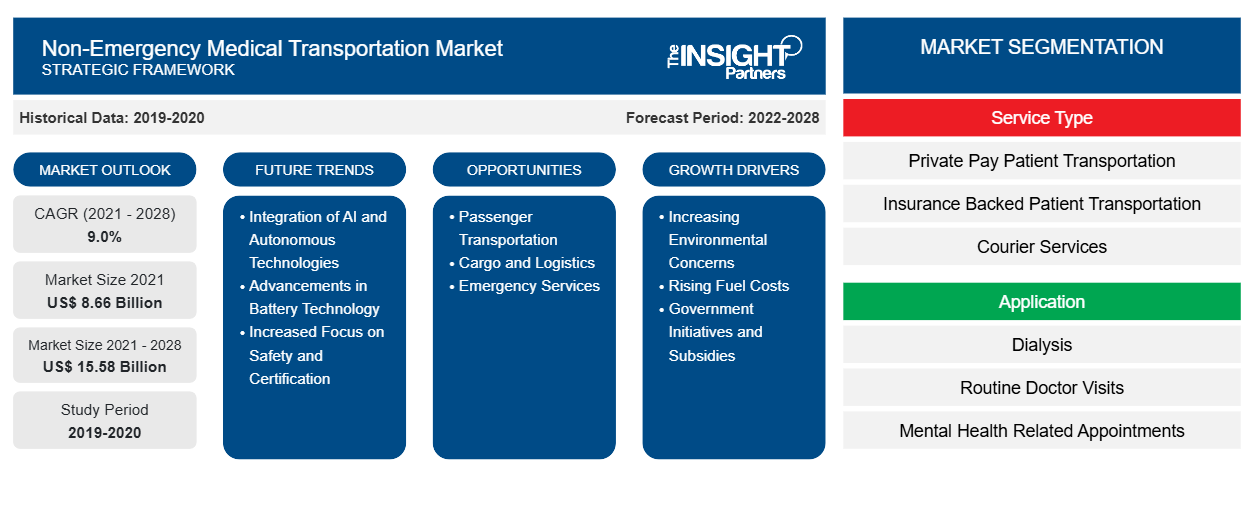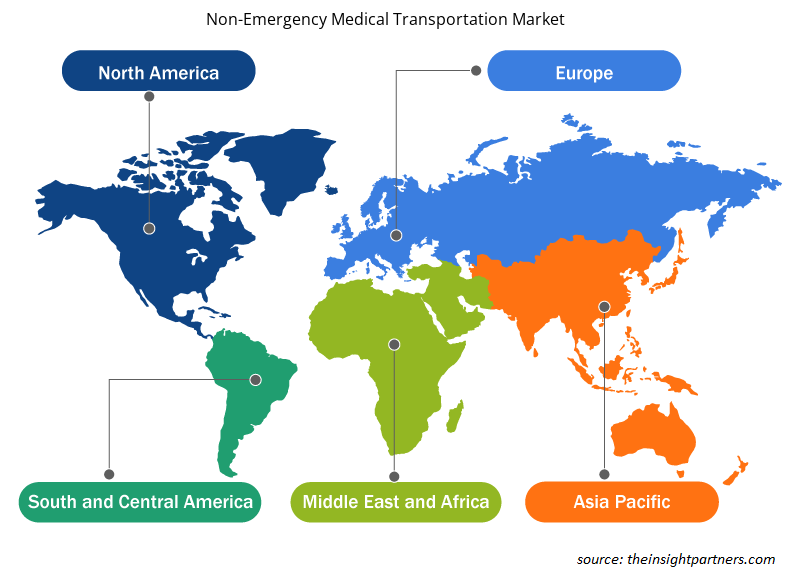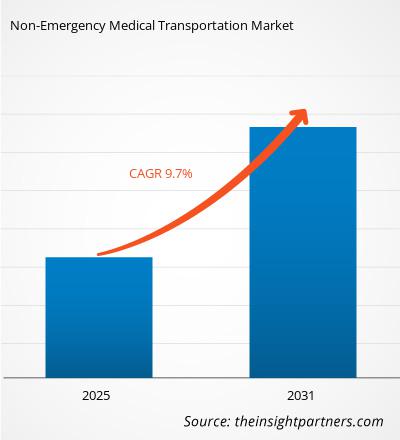Le marché du transport médical non urgent devrait atteindre 31 872,49 millions de dollars américains d'ici 2031, contre 16 714,80 millions de dollars américains en 2024. Le marché devrait enregistrer un TCAC de 9,7 % entre 2025 et 2031. Les avancées technologiques dans le domaine du transport médical non urgent devraient entraîner de nouvelles tendances sur le marché dans les années à venir.
Analyse du marché du transport médical non urgent
Les facteurs qui stimulent le marché du transport médical non urgent comprennent la demande croissante de transport médical non urgent et l'incidence croissante des maladies chroniques chez les personnes âgées. De plus, les avancées technologiques dans ce domaine devraient contribuer à la croissance du marché. Les initiatives stratégiques des acteurs du marché devraient créer de nombreuses opportunités dans les années à venir.
Aperçu du marché du transport médical non urgent
Français L'Amérique du Nord devrait dominer le marché du transport médical non urgent, et l'Asie-Pacifique devrait enregistrer un taux de croissance significatif en raison de la prévalence croissante des maladies chroniques chez les personnes âgées et de la demande croissante de solutions de soins de santé améliorées. L'augmentation des dépenses de santé et le développement des infrastructures de santé, ainsi que l'essor du tourisme médical, ont également accru la demande de transport médical non urgent dans les régions. Dans la région APAC , la Chine représente la part de marché la plus importante, et l'Inde enregistre un taux de croissance significatif dans la région. La Chine prévoit d'investir 1,5 billion de dollars américains au cours des prochaines années pour faire progresser davantage son innovation en matière de technologies de santé. En plus du plan Healthy China 2030, ces dépenses visent à garantir l'équité en matière de santé en Chine grâce aux avancées technologiques et aux améliorations du système de santé. Selon un rapport du ministère des Affaires civiles et du Comité national chinois sur le vieillissement , la Chine a l'une des plus grandes populations vieillissantes au monde. En 2023, il y avait plus de 297 millions de personnes âgées de 60 ans et plus, soit 21,1 % de la population totale. La population gériatrique chinoise est confrontée à une charge croissante de maladies chroniques , l'âge avancé étant le principal facteur de risque contribuant à leur apparition. Selon l'étude « Besoins non satisfaits en matière de maladies chroniques en Chine », publiée dans le BMJ Journal en 2024, les maladies non transmissibles ( MNT ) représentent la menace sanitaire la plus importante dans le pays, responsables de 91 % des décès. Les principales MNT en Chine sont les maladies cardiovasculaires (43 %), les cancers (23 %) et le diabète sucré (2 %).
Personnalisez ce rapport en fonction de vos besoins
Vous bénéficierez d'une personnalisation gratuite de n'importe quel rapport, y compris des parties de ce rapport, ou d'une analyse au niveau des pays, d'un pack de données Excel, ainsi que de superbes offres et réductions pour les start-ups et les universités.
Marché du transport médical non urgent : perspectives stratégiques

-
Obtenez les principales tendances clés du marché de ce rapport.Cet échantillon GRATUIT comprendra une analyse de données, allant des tendances du marché aux estimations et prévisions.
Moteurs et opportunités du marché du transport médical non urgent
Demande croissante de transport médical non urgent
Selon l'American Hospital Association, chaque année, environ 3,6 millions de personnes aux États-Unis ne reçoivent pas les soins médicaux nécessaires en raison de problèmes de transport (manque d'accès aux véhicules, longues distances pour se rendre aux établissements de santé, infrastructures de transport public inadéquates et coût élevé des transports). Une étude menée par UC Davis Health a révélé qu'environ 5,8 millions d'Américains manquent ou retardent chaque année des soins médicaux en raison d'obstacles au transport. Le transport est un facteur important contribuant aux rendez-vous médicaux manqués. Une enquête menée en 2019 par Kaiser Permanente a révélé qu'un tiers des Américains subissent fréquemment ou occasionnellement du stress lié aux transports.
Depuis 1965, Medicaid propose une prestation de transport médical non urgent (NEMT), et les personnes couvertes par Medicaid bénéficient de services de transport comme prestation essentielle. Selon le Medicaid Enrollment and Unwinding Tracker, environ 94 millions de personnes étaient inscrites à Medicaid jusqu'en avril 2023. L'enquête budgétaire Medicaid de la KFF prévoyait une augmentation de 8,2 % du nombre d'adhérents aux soins de santé en 2021 aux États-Unis, principalement due à la crise de la COVID-19 et à un taux de chômage élevé. L'accès croissant à Medicaid entraîne une augmentation directe de la demande de services NEMT.
La plupart des États américains ont adopté la mise en place de services NEMT par l'intermédiaire de courtiers NEMT ou d'organismes de soins gérés (OSG). Dans de nombreux États, les courtiers ou les OSG perçoivent une rémunération par habitant pour superviser les services NEMT, tandis que d'autres, comme le Nevada, l'Arizona et le Vermont, proposent des services NEMT à l'acte par l'intermédiaire de prestataires locaux. Le Programme d'assurance maladie pour enfants (CHIP) offre une couverture santé aux enfants admissibles via Medicaid et d'autres programmes CHIP. Le CHIP est administré par les États conformément aux exigences fédérales et financé conjointement par les gouvernements des États et du gouvernement fédéral. Par conséquent, avec la multiplication de ces initiatives gouvernementales, la demande de services NEMT augmente, stimulant ainsi la croissance du marché.
Les initiatives stratégiques de NEMT et des sociétés de réseaux de transport créent de nombreuses opportunités de croissance du marché
Les entreprises de transport et de gestion des transports (TGT) souhaitent entreprendre des actions stratégiques pour améliorer l'accès aux soins. Les TGT, comme Uber ou Lyft, sont réputées pour leurs services de VTC à la demande et leurs applications mobiles conviviales. Ces fonctionnalités permettent de résoudre efficacement les problèmes de disponibilité et de planification liés aux TGT. Plusieurs TGT développent actuellement de nouvelles plateformes ou collaborent avec des TGT et des prestataires de soins de santé du monde entier. Plusieurs agences gouvernementales autorisent le recours aux TGT pour fournir des TGT. En voici quelques exemples.
- En juin 2024, Uber a officiellement lancé Uber Santé, une plateforme destinée à aider les patients à se rendre à leurs rendez-vous médicaux, ce qui pourrait réduire les absences et améliorer la ponctualité. Conforme à la loi HIPAA, cette initiative offre une alternative économique aux services de taxi traditionnels, particulièrement avantageuse pour les petits établissements de santé dépourvus de moyens de transport dédiés. Présente dans plus de 250 villes américaines, la plateforme d'Uber, axée sur le secteur de la santé, élargit considérablement l'accès aux soins de santé non urgents.
- En janvier 2024, MediDrive, partenaire de CTG, a officiellement fait son entrée sur le marché des NEMT. L'entreprise se consacre à la gestion des complexités du transport des patients vers et depuis leurs rendez-vous et procédures médicaux.
- En juin 2022, MTM a lancé le programme Elevate pour une gestion proactive des voyages. MTM adopte une approche proactive pour la gestion des voyages de ses membres, en offrant un service de conciergerie pour les trajets complexes et en répondant aux besoins de transport spécifiques de ses membres.
- En février 2022, Modivcare Inc. a lancé la Modivcare Academy. Cette initiative innovante vise à accompagner les prestataires de transport de la région NEMT en leur proposant des ressources pédagogiques, des opportunités de réseautage et des formations. Ce programme unique offre aux prestataires de transport des outils commerciaux essentiels, des bonnes pratiques et des formations pour soutenir efficacement la prise en charge des populations les plus vulnérables du pays.
Ces initiatives stratégiques visent à améliorer l'efficacité des services, l'accessibilité des patients, la réduction des coûts opérationnels et une meilleure intégration avec les services de santé. À mesure que le secteur NEMT poursuit sa croissance, ces initiatives seront cruciales pour étendre les services et améliorer la qualité des soins aux patients à travers le monde.
Analyse de segmentation du rapport sur le marché du transport médical non urgent
Les segments clés qui ont contribué à l’élaboration de l’analyse du marché du transport médical non urgent sont le type de service, l’établissement, l’application et l’utilisateur final.
- Selon le type de service, le marché du transport médical non urgent est segmenté en transport de patients payant, transport de patients assuré, services de messagerie, etc. Le segment du transport de patients payant détenait la plus grande part de marché en 2024 et devrait enregistrer le TCAC le plus élevé du marché entre 2024 et 2031.
- Par établissement, le marché du transport médical non urgent se divise en deux catégories : intra-établissement et inter-établissement. Le segment inter-établissements a détenu une part de marché plus importante en 2024 et devrait enregistrer un TCAC plus élevé sur la période 2024-2031.
- Par application, le marché du transport médical non urgent est segmenté en dialyse, consultations médicales de routine, rendez-vous liés à la santé mentale, réadaptation, etc. Le segment des rendez-vous liés à la santé mentale détenait la plus grande part de marché en 2024 ; le segment de la réadaptation devrait enregistrer le TCAC le plus élevé du marché entre 2024 et 2031.
- En termes d'utilisateurs finaux, le marché du transport médical non urgent est segmenté en hôpitaux et cliniques, maisons de retraite, services de soins à domicile, organismes de santé et d'État, organismes payeurs de soins de santé, etc. Le segment des hôpitaux et cliniques a dominé le marché en 2024, et le segment des maisons de retraite devrait enregistrer le TCAC le plus élevé entre 2024 et 2031.
Analyse des parts de marché du transport médical non urgent par zone géographique
La portée géographique du rapport sur le marché du transport médical non urgent est principalement divisée en cinq régions : Amérique du Nord, Asie-Pacifique, Europe, Moyen-Orient et Afrique, et Amérique du Sud et centrale.
L'Amérique du Nord détenait une part importante du marché en 2023. La croissance du marché du transport médical non urgent est attribuée à la prévalence croissante de diverses maladies, à l'extension de la couverture d'assurance pour le transport médical non urgent (TMNE) et à un taux de remboursement élevé par État pour ces services, qu'il s'agisse de frais administratifs ou médicaux. De plus, l'évolution vers des soins centrés sur le patient, la sensibilisation accrue au TMNE et les avancées technologiques comptent parmi les autres facteurs qui soutiennent la croissance du marché. Les maladies chroniques, le vieillissement, les handicaps, les blessures et l'obésité ne sont que quelques-unes des nombreuses raisons pour lesquelles les Américains dépendent des services de transport médical non urgent. La pandémie a généré un besoin considérable de transports en voiture fiables pour se rendre aux rendez-vous, aux consultations médicales essentielles et aux traitements quotidiens. De plus, l'augmentation du nombre de personnes âgées contribue à la croissance du marché du transport médical non urgent aux États-Unis. Par ailleurs, les entreprises présentes sur ce marché adoptent des stratégies de développement organique et non organique pour se développer. En voici quelques exemples :
- Coastal Medical Transportation Systems (CMTS), une entreprise privée de transport médical basée dans le Massachusetts, a acquis la division transport médical de Transformative Healthcare en septembre 2022. Cette division comprenait LifeLine Ambulance Service et Fallon Ambulance Service. Suite à cette acquisition, CMTS est devenu l'un des plus grands réseaux d'ambulances de l'État, tant en termes de nombre de patients pris en charge que de zone géographique couverte.
- En septembre 2022, l'hôpital Baystate Wing s'est associé à Quaboag Connector pour fournir des services de transport aux professionnels de santé du Massachusetts. Ce service de transport de trottoir à trottoir propose le NEMT, permettant aux patients de demander un trajet vers et depuis leurs rendez-vous médicaux dans les établissements de l'hôpital Baystate Wing.
Aperçu régional du marché du transport médical non urgent
Les tendances et facteurs régionaux influençant le marché du transport médical non urgent tout au long de la période de prévision ont été analysés en détail par les analystes d'Insight Partners. Cette section aborde également les segments et la géographie du marché du transport médical non urgent en Amérique du Nord, en Europe, en Asie-Pacifique, au Moyen-Orient et en Afrique, ainsi qu'en Amérique du Sud et en Amérique centrale.

- Obtenez les données régionales spécifiques au marché du transport médical non urgent
Portée du rapport sur le marché du transport médical non urgent
| Attribut de rapport | Détails |
|---|---|
| Taille du marché en 2024 | 16 714,80 millions de dollars américains |
| Taille du marché d'ici 2031 | 31 872,49 millions de dollars américains |
| TCAC mondial (2025 - 2031) | 9,7% |
| Données historiques | 2021-2023 |
| Période de prévision | 2025-2031 |
| Segments couverts |
Par type de service
|
| Régions et pays couverts |
Amérique du Nord
|
| Leaders du marché et profils d'entreprises clés |
|
Densité des acteurs du marché du transport médical non urgent : comprendre son impact sur la dynamique des entreprises
Le marché du transport médical non urgent connaît une croissance rapide, portée par une demande croissante des utilisateurs finaux, due à des facteurs tels que l'évolution des préférences des consommateurs, les avancées technologiques et une meilleure connaissance des avantages du produit. Face à cette demande croissante, les entreprises élargissent leur offre, innovent pour répondre aux besoins des consommateurs et capitalisent sur les nouvelles tendances, ce qui alimente la croissance du marché.
La densité des acteurs du marché désigne la répartition des entreprises opérant sur un marché ou un secteur particulier. Elle indique le nombre de concurrents (acteurs) présents sur un marché donné par rapport à sa taille ou à sa valeur marchande totale.
Les principales entreprises opérant sur le marché du transport médical non urgent sont :
- MTM, Inc.
- RAM
- Transport Xpress
- Transport médical CJ
- VÉRIDA
Avertissement : Les entreprises répertoriées ci-dessus ne sont pas classées dans un ordre particulier.

- Obtenez un aperçu des principaux acteurs du marché du transport médical non urgent
Actualités et développements récents du marché du transport médical non urgent
Le marché du transport médical non urgent est évalué en collectant des données qualitatives et quantitatives issues d'études primaires et secondaires, incluant des publications d'entreprises importantes, des données d'associations et des bases de données. Voici quelques-unes des évolutions du marché du transport médical non urgent :
- Modivcare Inc. a lancé son Integration Hub, une plateforme numérique révolutionnaire qui révolutionne l'engagement et l'expérience des assurés Medicaid et Medicare bénéficiant des avantages NEMT. L'Integration Hub de Modivcare est une première dans le secteur : il s'agit d'une plateforme de mobilité modulaire et extensible qui met à disposition des interfaces de programmation d'applications (API) ouvertes à ses clients des régimes d'assurance maladie, aux agences Medicaid des États et à ses partenaires établissements de santé. (Source : ModivCare, site web de l'entreprise, mai 2024)
- MTM, le plus grand courtier privé en NEMT du pays, a signé un accord avec Global Medical Response pour l'acquisition d'Access2Care, LLC. Cette acquisition stratégique a considérablement renforcé la présence de MTM sur le marché et augmenté son chiffre d'affaires annuel total, marquant une étape importante dans la croissance de l'entreprise. L'acquisition de l'activité NEMT d'Access2Care est le fruit d'une réflexion approfondie et s'inscrit dans le cadre des initiatives d'expansion stratégique de MTM. (Source : MTM, Inc., site web de l'entreprise, août 2024)
- Le Service ambulancier Acadian a annoncé la signature d'un accord portant sur l'acquisition de la quasi-totalité des actifs de SouthernCross Ambulance, un prestataire de services médicaux d'urgence basé à New Braunfels, au Texas. Cette acquisition permet à Acadian d'exploiter 12 ambulances et 10 fourgonnettes supplémentaires pour fauteuils roulants, ainsi que d'embaucher de nouveaux employés. SouthernCross Ambulance offre des services de transport ambulancier, urgents et non urgents, dans les régions du Centre-Sud et du Sud du Texas, assurant des transports ambulanciers locaux et longue distance vers et depuis les hôpitaux, les centres de réadaptation, les cliniques, les maisons de retraite et les centres de soins infirmiers spécialisés. (Source : Service ambulancier Acadian, site web de l'entreprise, janvier 2024)
Rapport sur le marché du transport médical non urgent : couverture et livrables
Le rapport « Taille et prévisions du marché du transport médical non urgent (2021-2031) » fournit une analyse détaillée du marché couvrant les domaines suivants :
- Taille et prévisions du marché du transport médical non urgent aux niveaux mondial, régional et national pour tous les segments de marché clés couverts par le champ d'application
- Tendances du marché du transport médical non urgent ainsi que la dynamique du marché telles que les conducteurs, les contraintes et les opportunités clés
- Analyse PEST et SWOT détaillée
- Analyse du marché du transport médical non urgent couvrant les principales tendances du marché, le cadre mondial et régional, les principaux acteurs, les réglementations et les développements récents du marché
- Analyse du paysage industriel et de la concurrence couvrant la concentration du marché, l'analyse de la carte thermique, les principaux acteurs et les développements récents pour le marché du transport médical non urgent
- Profils d'entreprise détaillés
- Analyse historique (2 ans), année de base, prévision (7 ans) avec TCAC
- Analyse PEST et SWOT
- Taille du marché Valeur / Volume - Mondial, Régional, Pays
- Industrie et paysage concurrentiel
- Ensemble de données Excel
Rapports récents
Rapports connexes
Témoignages
Raison d'acheter
- Prise de décision éclairée
- Compréhension de la dynamique du marché
- Analyse concurrentielle
- Connaissances clients
- Prévisions de marché
- Atténuation des risques
- Planification stratégique
- Justification des investissements
- Identification des marchés émergents
- Amélioration des stratégies marketing
- Amélioration de l'efficacité opérationnelle
- Alignement sur les tendances réglementaires






















 Obtenez un échantillon gratuit pour - Marché du transport médical non urgent
Obtenez un échantillon gratuit pour - Marché du transport médical non urgent